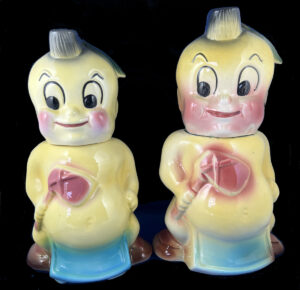Started in 1919:

American Bisque originally a maker of Kewpie doll heads, was sold to B.E. Allen in 1922 and stayed with the Allen family until the company sold in 1982. The company was located in Williamstown, West Virginia.
Identification:
Large wedge shapes on the bottom of the jars are one way to tell an American Bisque jar. Often their jars are marked with U.S.A. and sometimes with a mold number. Airbrushing is common on American Bisque jars and adds to their distinctive look.
Confusing Genealogy:
As with several other pottery companies during the early production of jars, the history gets a little fuzzy. Pottery companies that were intertwined with American Bisque include American Pottery, Ludowici Celadon and Terrace Ceramics. To further complicate the history, American Bisque made and decorated jars that were (then) distributed by Cardinal China Company.
Products:
The company was known for their planters, banks, pitchers and cookie jars were especially some of American Bisque’s popular products. They were one of the few companies that used lenticular printing to create the flasher jars!

Fakes and Reproductions:
As with many of pottery companies, reproductions are a problem when looking for American Bisque jars. Especially beware of the higher priced jars such as Casper, Mohawk Indian, Baby Huey, Little Audrey, the Flintstones jars and the Popeye series.
Sizes are always a giveaway as reproduction jars are always smaller than the original piece. Shown below is Pottery by JD on left, authentic American Bisque on right side.

The Bottom Line:
One of the more prolific and popular manufacturers of cookie jars, American Bisque jars are well-made, heavy jars and loved by collectors. From the simple canister jar to the holy grail jars, there’s something for every collector. Values can range from under $100 to the many thousands of dollars depending on the rarity, the condition and variations of the jar in question.
Read More:
From the @barbcrews archives


